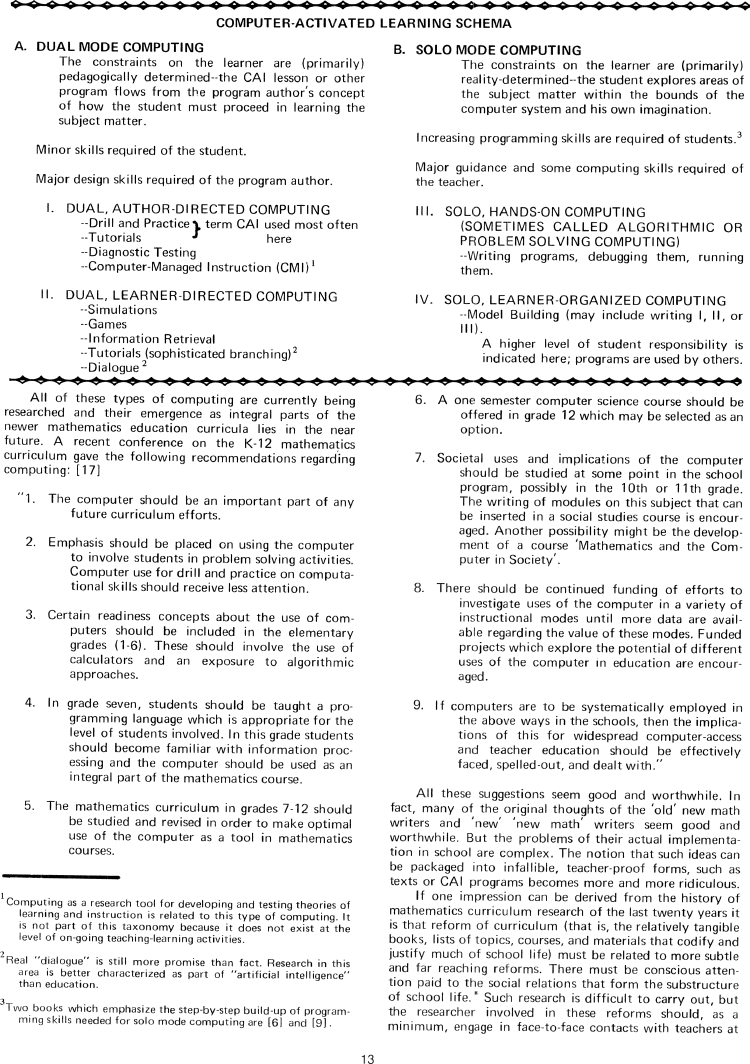The Best of Creative Computing Volume 1 (published 1976)
Recent Trends in Mathematics Curriculum Research

COMPUTER-ACTIVATED LEARNING SCHEMA
A. DUAL MODE COMPUTING
The constraints on the learner are (primarily) pedagogically determined--the CAI
lesson or other
program flows from the program author's concept of how the student must proceed
in learning the
subject matter.
Minor skills required of the student.
Major design skills required of the program author.
I. DUAL, AUTHOR-DIRECTED COMPUTING
--Drill and Practice} term CAI used most often
--Tutorials here
--Diagnostic Testing
--Computer-Managed Instruction (CMI)1
II. DUAL, LEARNER-DIRECTED COMPUTING
--Simulations
--Games
--Information Retrieval
--Tutorials (sophisticated branching)2
--Dialogue 2
All of these types of computing are currently being researched and their
emergence as integral parts of the
newer mathematics education curricula lies in the near future. A recent
conference on the K-12 mathematics
curriculum gave the following recommendations regarding computing: [17]
"1. The computer should be an important part of any future curriculum efforts.
2. Emphasis should be placed on using the computer to involve students in
problem solving activities.
Computer use for drill and practice on computational skills should receive less
attention.
3. Certain readiness concepts about the use of computers should be included in
the elementary grades (1-6). These should involve use of calculators and an
exposure to algorithmic approaches.
4. In grade seven, students should be taught a programming language which is
appropriate for the level of students involved. In this grade students should
become familiar with information processing and the computer should be used as
an integral part of the mathematics course.
5. The mathematics curriculum in grades 7-12 should be studied and revised in
order to make optimal
use of the computer as a tool in mathematics courses.
1
Computing as a research tool for developing and testing theories of learning
and instruction is related to this type of computing. It is not part of this
taxonomy because it does not exist at the level of on-going teaching-learning
activities.
2
Real "dialogue" is still more promise than fact. Research in this area is
better characterized as part of "artificial intelligence" than education.
3
Two books which emphasize the step-by-step build-up of programming skills
needed for solo mode computing are [6] and [9].
B.SOLO MODE COMPUTING
The constraints on the learner are (primarily) reality-determined--the student
explores areas of
the subject matter within the bounds of the computer system and his own
imagination.
Increasing programming skills are required of students.3
Major guidance and some computing skills required of the teacher.
III. SOLO, HANDS-ON COMPUTING
(SOMETIMES CALLED ALGORITHMIC OR PROBLEM SOLVING COMPUTING)
--Writing programs, debugging them, running them.
IV. SOLO, LEARNER-ORGANIZED COMPUTING
--Model Building (may include writing I, ll, or Ill).
A higher level of student responsibility is indicated here; programs are used by
others.
6. A one semester computer science course should be offered in grade 12 which
may be selected as an
option.
7. Societal uses and implications of the computer should be studied at some
point in the school program, possibly in the 'l0th or 11th grade. The writing of
modules on this subject that can be inserted in a social studies course is
encouraged. Another possibility might be the development of a course
'Mathematics and the Computer in Society'.
8. There should be continued funding of efforts to investigate uses of the
computer in a variety of instructional modes until more data are available
regarding the value of these modes. Funded projects which explore the potential
of different uses of the computer in education are encouraged.
9. If computers are to be systematically employed in the above ways in the
schools, then the implications of this for widespread computer-access and
teacher education should be effectively faced, spelled-out, and dealt with."
All these suggestions seem good and worthwhile. In fact, many of the original
thoughts of the 'old' new math
writers and 'new' 'new math' writers seem good and worthwhile. But the problems
of their actual implementation in school are complex. The notion that such ideas
can be packaged into infallible, teacher-proof forms, such as texts or CAI
programs becomes more and more ridiculous.
If one impression can be derived from the history of mathematics curriculum
research of the last twenty years it is that reform of curriculum (that is, the
relatively tangible books, lists of topics, courses, and materials that codify
and justify much of school life) must be related to more subtle and far reaching
reforms. There must be conscious attention paid to the social relations that
form the substructure of school life.* Such research is difficult to carry out,
but the researcher involved in these reforms should, as a
minimum, engage in face-to-face contacts with teachers at


